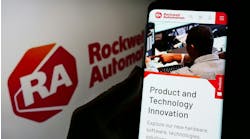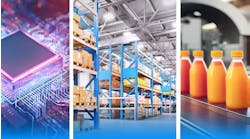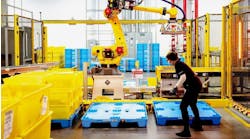Making more industrial goods, making less industrial emissions
Ericsson’s Bhushan Joshi
The demand for industrial goods is expected to increase exponentially in the next decade. And per the Paris Climate Agreement, the industrial sector is being asked to reduce emissions by 50% by 2030.
So how do we reconcile these two elements? Here we connected with Bhushan Joshi, Ericsson’s head of sustainability & corporate responsibility, who shares his thoughts on the role of connectivity in overcoming pollution obstacles and capitalizing on opportunities while achieving carbon-neutrality goals. Take a look…
Smart Industry: How do you define "connectivity" in the manufacturing realm in this data-driven age?
Bhushan: To address this question, we must first consider the market forces facing manufacturing companies globally. Consumers expect specialized products, which require increasingly complex components that put pressure on business margins. According to Ericsson’s industry reports, when it comes to 5G for manufacturing, competitiveness is everything and gains in efficiency and profitability will be achieved by new process innovations, including automation of robots, transportation warehouses and wireless connectivity that provides flexibility needed for rapid reconfiguration of production processes. There are also many network characteristics of 5G that help enable these process innovations. This includes low latency and high bandwidth and reliability for critical applications.
Altogether, 5G networks offer manufacturers the chance to build smart factories and to take advantage of technologies such as automation, artificial intelligence, augmented reality for troubleshooting, and the Internet of Things (IoT).
Smart Industry: How/why can connectivity enable decarbonization/cleaner manufacturing?
Bhushan: The industrial sector is responsible for 32% of global greenhouse gas (GHG) emissions and the demand for industrial goods is expected to rise as the global middle class is projected to reach 5.2 billion exponentially by 2030. Given this, the challenge for the industrial sector is to meet these societal demands while reducing GHG emissions by 50% each decade and aiming to reach net zero emissions by 2050, in order to achieve the objectives of the Paris Climate Accord.
The Exponential Climate Action Roadmap Report, of which Ericsson is a lead partner, outlines existing technologies like materials recirculation, production efficiency and circular business models that can be implemented by the industrial sectors to cut annual emissions by 50% in this decade. This report also identifies digital technologies (including connectivity) as one of the accelerators of decarbonization for the industrial sector.
Ericsson estimates there will be 26.9 billion IoT devices around the world by 2026. These devices can be used to track parameters like location, temperature and flow rates, and this data can be used as inputs to optimize the flow of materials and resources throughout the product lifecycle.
Smart Industry: What are the most common wins with this approach? What are the most stubborn challenges?
Bhushan: Ericsson has been working on 5G and IIoT solutions, which enable factories to seamlessly create a network of wirelessly connected machines and people, who can collect, analyze data and take action in real time, allowing for product customization and production maximization. Reducing energy intensity of a production process can reduce the embodied carbon emissions in products. Real time monitoring of production process and resource usage (i.e. kWh), along leveraging AI techniques for continual process optimization, can drive up to 20% reduction in the industrial sector’s annual energy intensity.
Circular economy and close-loop business models focus on maximizing the recirculation of materials and components by keeping them in the use stage of a product’s lifecycle for as long as possible. This approach has both environmental and societal benefits. The Exponential Roadmap Report states that increased circular economy approach could cut 45% of cumulative emissions from steel, cement, plastic and aluminum products globally. Enabling circular economy concepts on scale requires setting up reverse logistics processes, as well as real time tracing of materials and products to increase utilization of consumers goods and other assets such as vehicles.
Ericsson’s mobility report predicts that 5G population coverage is expected to reach 60% by 2026 and IoT devices are estimated to be available by that same timeframe, which combined will provide the precision required to optimize production process and accelerate the adoption of circular economy concepts.
Some of the key obstacles for rapid decarbonization in the industrial sector are lack of strong policy, slow consumer adoption rates and weak investments. To overcome these barriers action is required on multiple fronts includes creating policies and incentives for low-emission products and business models. Increased expectation on companies in the manufacturing sector to set decarbonization targets aligned with climate science and making it easy for consumers to select products designed based on circular economy concepts.
Smart Industry: How does the 5G Smart Factory embody this approach?
Bhushan: At the US 5G Smart Factory, Ericsson is implementing innovative ICT solutions to increase production efficiency, reduce resource consumption and adopt renewables to show how manufacturing can transition to a low-carbon future and meet key business objectives.
We are achieving these objectives by focusing on a plethora of key business initiatives such as achieving carbon neutrality and taking climate action through innovation. Ericsson has set a goal to become carbon neutral for company operations by 2030 and commitments to climate change have been integrated into the design of the 5G Smart Factory. Some of these innovations include the factory’s 40,000-gallon water tanks that collect and reuse rainwater, as well as renewable energy fully powering the site. Notably, the factory will be the first Ericsson facility globally to achieve both the LEED Gold and LEED Zero Carbon certifications and it’s designed to be up-to 24% more energy efficient than a comparable building.
In order to further contribute to the reduction of carbon emissions, Ericsson has deployed 4G-enabled energy monitoring at the smart factory that helps provide real-time energy consumption data and can turn off equipment based on pre-installed settings. Additionally, environmental monitoring at the smart factory collects and analyzes parameters such as temperature and humidity, which can waste precious resources when fluctuating.
Smart Industry: How is digitalization affecting climate change? How is 5G coming into play in this respect?
Bhushan: To understand how digitalization is affecting climate change, we must consider the carbon footprint of the digital sector and its potential to enable other sectors of our economy pursue decarbonization pathways that are aligned with climate science.
The carbon footprint of the information and communications technology (ICT) sector is estimated to be 1.4% of the global total. Between 2010 and 2015, as the global data traffic quadrupled and the number of mobile subscribers increased by 30%, the ICT sectors emissions remained roughly constant due to gains in energy efficiency. Currently the total annual energy costs of running mobile networks globally is around $25B. As 5G networks continue being deployed nationwide to support the 3.6 times increase in mobile data traffic forecasted for North America, the ICT sector is taking on the question of how to quadruple data traffic without increasing energy consumption.
Ericsson has always regarded energy performance as one of the key requirements for 5G and our research team has continued to drive energy-efficient network concepts into 3GPP standards. Last year Ericsson introduced its Breaking the Energy Curve (BTEC) framework that can enable the rollout of 5G without increasing energy consumption. This holistic framework has four key elements; modernizing the network with the latest technology to significantly save energy, activating energy-saving features to reduce energy consumption without sacrificing user experience, building 5G with precision and operating site infrastructure using AI to reduce network energy consumption.
The ICT sector is a game-changing technology that can help combat climate change. Existing digital technologies can help reduce global GHG emissions by up to 15% through solutions in energy, manufacturing, agriculture and land use, buildings, services and transportation, which corresponds to a third of the GHG emission reduction required by 2030. 5G and IoT technologies can take the pace of transformation to the next level and help to achieve the objectives of the Paris Climate Agreement.
It's estimated that there will be 4.1 billion cellular IoT connections globally by 2024 (IoT Connections Outlook). These modernized concepts and sensors in factories, cities, farms and in our homes will provide us with the foundational elements to innovate and drive the required decarbonization. This, enabled by 5G AI and ML, will ultimately support a sustainable future for everyone.
Smart Industry: What most excites you about opportunities we have to make positive changes in this space in the immediate future?
Bhushan: The 5G smart factory provides access to innovative technologies and careers of the future. Our digitally skilled workforce is part of a team shaping the next innovation platform. The people aspect of the 5G Smart Factory excites me the most because our products manufactured there can accelerate mobile broadband deployment and help close the digital divide in North America, creating careers of the future.
According to a report by The National Association of Manufacturing and Deloitte, more than 3.5 million STEM jobs will have to be filled by 2025. Access to quality education and lifelong learning are essential for developing skills that will likely be required in the future. However, according to the FCC, 21 million Americans lack access to high speed internet. As demand for STEM jobs increases, there is also an increasing importance to address the digital divide that expands the inequities in our society. It’s exciting to think about the potential of the smart factory as a learning center. Embedded with the community, the smart factory can inspire young people, especially girls and those from minority and low-income backgrounds, to untap the potential of innovation and to choose STEM careers.




